|
The Shakuhachi: The Voice of a Pure Spirit
|
Fujiyama Dojo P.O. Box 20003 Thorold, ON, Canada L2V 5B3 (905) 680-6389 |
|---|
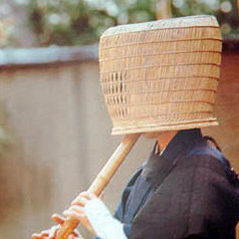 For those who have heard the music of a shakuhachi in the quiet surroundings of a Japanese garden there may not be a more haunting sound.
To a truly receptive ear, the melody of the bamboo flute seems to evoke mysterious images, and speak directly to our spirit, in a way that cannot be properly described. Some speak of a calming effect, while others go as far as feeling transported to another time in history. But in truth there is no mysticism in its very distinctive tones, and its effect has a lot to do with the listener's spirit. It can be best explained by a conversation I heard, while resting by the shore of a northern lake. It was shortly after dusk and two ladies were sitting not far from where I was. Suddenly, the silence was broken by the cry of a loon. "What a beautiful sound!", said one. "What the heck was that noise?" said the other.
And there lies a deep truth that may explain a lot of things in life, but that would be the topic for another type of discussion, not intended to be part of this narrative. For those who have heard the music of a shakuhachi in the quiet surroundings of a Japanese garden there may not be a more haunting sound.
To a truly receptive ear, the melody of the bamboo flute seems to evoke mysterious images, and speak directly to our spirit, in a way that cannot be properly described. Some speak of a calming effect, while others go as far as feeling transported to another time in history. But in truth there is no mysticism in its very distinctive tones, and its effect has a lot to do with the listener's spirit. It can be best explained by a conversation I heard, while resting by the shore of a northern lake. It was shortly after dusk and two ladies were sitting not far from where I was. Suddenly, the silence was broken by the cry of a loon. "What a beautiful sound!", said one. "What the heck was that noise?" said the other.
And there lies a deep truth that may explain a lot of things in life, but that would be the topic for another type of discussion, not intended to be part of this narrative.
The Two Travels of the Bamboo Flute
In addition to its virtue as musical instrument, the shakuhachi has the privilege of having a rather fascinating history that interconnects religion, warfare, politics, martial arts, and, of course, music. The name shakuhachi refers to the length of the flute: one "shaku", and eight "sun". A shaku is a measuring unit equivalent to ten "sun". A sun was described as approximately "the length of the second phalanx of the middle finger". The origin of the instrument can be traced back to China, during the Tang dynasty, and seemed to have reached Japan during the Nara period, where it became part of Gagaku, or Court music. But by the Heian period, due to the changes in Court music, the shakuhachi fell into disuse, and by the twelfth century seemed to be all but forgotten. Eight surviving flutes from this time are kept at the Shoso-in art repository, in Nara, and considered to be national treasures. It was not until 1254, during the Kamakura period, that the bamboo flute experienced a second migration, thanks to a priest named Kakushin. Kakushin traveled to China to study Zen Buddhism. There he visited several temples, and in one of them he was fortunate enough find a man named Shen practicing meditation. Shen happened to be the sixteenth inheritor of the shakuhachi music tradition called "Yearning After the Bell", in direct genealogical line from its founder, Zhang Bo. Both men developed a close friendship, and before long Kakushin became a virtuoso of the bamboo flute, which he dubbed "Fuke Shakuhachi", in honor of an eccentric Chinese priest named Puhua, who wandered the country preaching Zen doctrine, and ringing a bell as he asked for alms. Puhua reads "Fuke" in Japanese. Kakushin felt that the shakuhachi was a useful tool to aid Zen meditation, and he incorporated playing the flute into his daily practices, and creating, some say, a style of his own which, allegedly, seems to have influenced his own teacher. Eventually, Kakushin returned to Japan. With him came four shakuhachi players, and they all came to reside in the Tofuku-ji temple. The Japanese priest would later go on to found the Kokoku-ji temple, in Kishu. Many came to study Zen under Kakushin, and he dutifully encouraged every disciple to learn to play the shakuhachi, going so far as to recommend it instead of contemplative meditation. This doctrine became one of the characteristics of the Zen sect he would later establish: the Fuke-shu. The Fuke-shu, as a subsect of Zen Buddhism, could have been considered an obscure off-shoot, had it not developed a rather controversial representative figure: The Komu-so. The Komu-so - The Faceless Priest
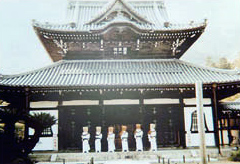 The itinerant mendicant priests of the Fuke-shu are a highly recognizable image, both now and in the pages of history. They carried with them their flutes, a straw mat(komo); wore cloth covering for the back of the hands (tekko), and gaiters. And they all covered their heads with a sedge basket, a particular part of their attire that would later be recognized as a symbol of their status.
The name Komu-so is a corruption of "komo-so", which means "priests with straw mats", a befitting name when one takes into consideration that the straw mat served as sitting area, as rain coat, as a blanket, and, for many, it was the closest thing to a "home" that they had during their journeys.
The Komu-so did not chant sutras, did not submit themselves to long fasts, did not shave their heads, did not dress in rags, did not mortify their bodies, did not fall into self- induced trances, did not engage in static speeches, nor withdraw into isolated areas. Playing the shakuhachi, however, was the focus of their practice, instead of formal meditation, and this gave them a certain separation from the world around them.
Judging by the previous description, the Komu-so appears to be little more than a somewhat unorthodox sect, with a proclivity for music. But in the midst of that we find a fascinating blend of circumstances that makes the Komu-so a much more complex group.
We must not forget the sociohistorical context in which they lived. Japan was hardly a peaceful place. From the late Kamakura to the early Muromachi period, the history of Japan could be described as a long battle with some small and sporadic rest periods. The same can be said of the Azuchi-Momoyama, regardless of the hegemony achieved by Nobunaga. In such an environment there was no shortage of individuals who were dissatisfied with their lives and longed for a clean break. Added to that list were masterless samurai, army deserters, even outlaws, and men who, for some reason, wanted to disappear from the public eye. All of these could be found among the Komu-so.
Some may argue that not all those who wandered around the fringes of society, playing a flute with a basket on their heads were true komu-so, and that might be true if we are to judge them as followers of the Fuke-shu. Quite a few historical anecdotes seem to back up this assumption. A member of the Ida family, a samurai of middle rank, while traveling in Kyushu, came to the defense of friend who was being forced to step on a fumi-e tablet (a sort of religious picture) by local officials. Had his friend refused to do so he would have incriminated himself. Ida's unexpected action ended up in bloodshed, and he found himself an outlaw. He found refuge as a komu-so. We know nothing of his musical skills, but he managed to live to a ripe old age. A similar path was followed by a samurai, an ancestor of the Shigemura family, originally from Fukushima, who after becoming a proscribed person for the slaying of a prominent man, ended up, and survived, as komu-so. Although he did not end his life as a wandering priest, his accounts of the time he spent as one make for fascinating reading.
Of course, since we have been taught that these were not isolated cases, it is safe to assume that the nature of the flute playing wandering priests was not as homogenous as we would like to think . But as a contemporary shakuhachi master once joked. "If all of them learned to play well, why be choosy?" The itinerant mendicant priests of the Fuke-shu are a highly recognizable image, both now and in the pages of history. They carried with them their flutes, a straw mat(komo); wore cloth covering for the back of the hands (tekko), and gaiters. And they all covered their heads with a sedge basket, a particular part of their attire that would later be recognized as a symbol of their status.
The name Komu-so is a corruption of "komo-so", which means "priests with straw mats", a befitting name when one takes into consideration that the straw mat served as sitting area, as rain coat, as a blanket, and, for many, it was the closest thing to a "home" that they had during their journeys.
The Komu-so did not chant sutras, did not submit themselves to long fasts, did not shave their heads, did not dress in rags, did not mortify their bodies, did not fall into self- induced trances, did not engage in static speeches, nor withdraw into isolated areas. Playing the shakuhachi, however, was the focus of their practice, instead of formal meditation, and this gave them a certain separation from the world around them.
Judging by the previous description, the Komu-so appears to be little more than a somewhat unorthodox sect, with a proclivity for music. But in the midst of that we find a fascinating blend of circumstances that makes the Komu-so a much more complex group.
We must not forget the sociohistorical context in which they lived. Japan was hardly a peaceful place. From the late Kamakura to the early Muromachi period, the history of Japan could be described as a long battle with some small and sporadic rest periods. The same can be said of the Azuchi-Momoyama, regardless of the hegemony achieved by Nobunaga. In such an environment there was no shortage of individuals who were dissatisfied with their lives and longed for a clean break. Added to that list were masterless samurai, army deserters, even outlaws, and men who, for some reason, wanted to disappear from the public eye. All of these could be found among the Komu-so.
Some may argue that not all those who wandered around the fringes of society, playing a flute with a basket on their heads were true komu-so, and that might be true if we are to judge them as followers of the Fuke-shu. Quite a few historical anecdotes seem to back up this assumption. A member of the Ida family, a samurai of middle rank, while traveling in Kyushu, came to the defense of friend who was being forced to step on a fumi-e tablet (a sort of religious picture) by local officials. Had his friend refused to do so he would have incriminated himself. Ida's unexpected action ended up in bloodshed, and he found himself an outlaw. He found refuge as a komu-so. We know nothing of his musical skills, but he managed to live to a ripe old age. A similar path was followed by a samurai, an ancestor of the Shigemura family, originally from Fukushima, who after becoming a proscribed person for the slaying of a prominent man, ended up, and survived, as komu-so. Although he did not end his life as a wandering priest, his accounts of the time he spent as one make for fascinating reading.
Of course, since we have been taught that these were not isolated cases, it is safe to assume that the nature of the flute playing wandering priests was not as homogenous as we would like to think . But as a contemporary shakuhachi master once joked. "If all of them learned to play well, why be choosy?"
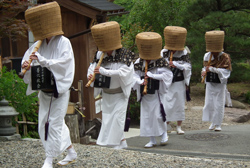 Joking aside, however, the fact remains that, for the Komu-so, not all was as it seems. It is interesting to point out that even the flute itself was not just a musical instrument. A number of techniques have survived in some Bujutsu ryu that use the flute as a defensive weapon.
With the arrival of the Edo period, another turn of events added to the mystique of the Komu-so. The Komu-so were granted the legal protection of the Tokugawa Shogunate. The shakuhachi became a "religious instrument" and the basket headpiece a "religious crown". They received permission to travel freely, and were authorized to kill any commoner who would touch their shakuhachi or headgear. Several hypotheses have been considered as logical explanations for the Shogunate's exemption of the Komu-so. The first one that comes to mind is the logical need that the Shogunate felt about exerting some control over the potentially conflictive and obviously able group. Moreover, the privileges granted to them also isolated them from other religious sects. But another fact to consider was that the Shogunate began to make very practical use of the Komu-so as informants, spies and even as assassins. The Komu-so were very effective at pursuing and neutralizing bandits, outlaws and even masterless samurai who had become dangerous. Their activities can be defined as covert operations, but the reputation of the Komu-so was, by no means, a subtle one.
There is historical "rumor" that the use of the Komu-so as a kind of Shogunate's "special forces", so to speak, was the brainchild of Konchiin Suden. He was a priest of the Nanzen-ji temple, who had strong ties with and was a confidant and adviser for the Shogunate. Joking aside, however, the fact remains that, for the Komu-so, not all was as it seems. It is interesting to point out that even the flute itself was not just a musical instrument. A number of techniques have survived in some Bujutsu ryu that use the flute as a defensive weapon.
With the arrival of the Edo period, another turn of events added to the mystique of the Komu-so. The Komu-so were granted the legal protection of the Tokugawa Shogunate. The shakuhachi became a "religious instrument" and the basket headpiece a "religious crown". They received permission to travel freely, and were authorized to kill any commoner who would touch their shakuhachi or headgear. Several hypotheses have been considered as logical explanations for the Shogunate's exemption of the Komu-so. The first one that comes to mind is the logical need that the Shogunate felt about exerting some control over the potentially conflictive and obviously able group. Moreover, the privileges granted to them also isolated them from other religious sects. But another fact to consider was that the Shogunate began to make very practical use of the Komu-so as informants, spies and even as assassins. The Komu-so were very effective at pursuing and neutralizing bandits, outlaws and even masterless samurai who had become dangerous. Their activities can be defined as covert operations, but the reputation of the Komu-so was, by no means, a subtle one.
There is historical "rumor" that the use of the Komu-so as a kind of Shogunate's "special forces", so to speak, was the brainchild of Konchiin Suden. He was a priest of the Nanzen-ji temple, who had strong ties with and was a confidant and adviser for the Shogunate.
As Time Changed
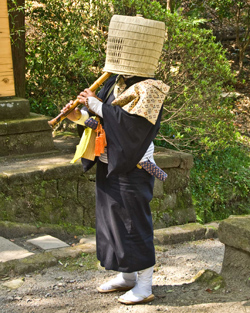 With the advent of the Meiji era, the status of the Komu-so changed. Their privileges were suspended. The Fuke-sho and the komu-so temples were dissolved. Although the vast majority of members abandoned the priesthood and did their best to re-enter society. Some of them continued cultivating and promoting their music. Some taught martial arts. Some became artisans(one very prominent shakuhachi maker of today is a direct descendant of a former komu-so who chose that path), etc.
One important triumph for the shakuhachi music, although no longer considered religious, was the fact that a petition brought to the new government by shakuhachi musicians to continue promoting their music was granted, and by this its survival was given a second chance. It was a successful one, since the instrument is still among us.
During the Second World War, a relative was briefly stationed in Singapore. While there, he worked at a former YMCA building used for military purposes, and he was happy to find another shakuhachi player among the officers(much better than himself)who, from time to time, indulged in small performances. He tried to befriend him, but made the unthinkable mistake of commenting on how the flute could also be used as a weapon. The officer, who was obviously a purist when it came to his instrument and its purpose, responded brusquely, expressing his disgust in no uncertain terms, and so ended the possible friendship between the two musicians.
The shakuhachi has had a fascinating history that has left its mark at many levels besides the musical one: the religious, the military, the social; even in the popular (for lack of a better word) vernacular. In the Japanese mizu shobai(or water trade, euphemism for prostitution) the term "shakuhachi" refers to fellatio. Even the more Impolite" name, "oshaku", is the combination of the honorific prefix "o" and the abbreviated form of shakuhachi. This might be a crude note, for which I apologize, but I believe it offers another testimony of the shakuhachi's enduring presence.
In truth, the shakuhachi has resisted the passing of time. it can still be heard and enjoyed. The success of Komu-so Festival, at Kokuji-temple, three years ago, was testimony of this. With the advent of the Meiji era, the status of the Komu-so changed. Their privileges were suspended. The Fuke-sho and the komu-so temples were dissolved. Although the vast majority of members abandoned the priesthood and did their best to re-enter society. Some of them continued cultivating and promoting their music. Some taught martial arts. Some became artisans(one very prominent shakuhachi maker of today is a direct descendant of a former komu-so who chose that path), etc.
One important triumph for the shakuhachi music, although no longer considered religious, was the fact that a petition brought to the new government by shakuhachi musicians to continue promoting their music was granted, and by this its survival was given a second chance. It was a successful one, since the instrument is still among us.
During the Second World War, a relative was briefly stationed in Singapore. While there, he worked at a former YMCA building used for military purposes, and he was happy to find another shakuhachi player among the officers(much better than himself)who, from time to time, indulged in small performances. He tried to befriend him, but made the unthinkable mistake of commenting on how the flute could also be used as a weapon. The officer, who was obviously a purist when it came to his instrument and its purpose, responded brusquely, expressing his disgust in no uncertain terms, and so ended the possible friendship between the two musicians.
The shakuhachi has had a fascinating history that has left its mark at many levels besides the musical one: the religious, the military, the social; even in the popular (for lack of a better word) vernacular. In the Japanese mizu shobai(or water trade, euphemism for prostitution) the term "shakuhachi" refers to fellatio. Even the more Impolite" name, "oshaku", is the combination of the honorific prefix "o" and the abbreviated form of shakuhachi. This might be a crude note, for which I apologize, but I believe it offers another testimony of the shakuhachi's enduring presence.
In truth, the shakuhachi has resisted the passing of time. it can still be heard and enjoyed. The success of Komu-so Festival, at Kokuji-temple, three years ago, was testimony of this.
For Those Interested in the Shakuhachi
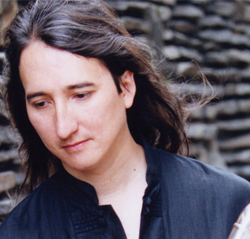 In Japan, we recommend a trip to Shinjuku-ku, Tokyo, to visit a shop called Mejiro. Its address is Daikan Plaza Bldg. 2F, 1-31-8 Takadanobaba Shinjuku-ku, Tokyo. One can find anything about the shakuhachi there, including books, videos, CDs. You can even take lessons, or learn how to make a bamboo flute.
And for those in North America, who already like the haunting music of this ancient instrument, or those who would like to see what it is all about, we wholeheartedly recommend a Canadian virtuoso and composer named Ron Korb, who has performed in Japan, China, Europe, and- of course- North America. Watch for any of his concerts and there could be no better introduction.
Some of his best music can be heard on his CDs Flute Traveler, Japanese Mysteries, Tear of the Sun and Behind the Mask.
Quite frankly, for a peaceful time, for a time to give the mind and the body a rest, the shakuhachi is quite a beneficial tonic. Pieces like "Samidare", or "Shika no Tone" can mentally transport us to the beautiful gardens of Isasumi shrine, take us near the small waterfalls of Setogaro valley, bring us to the edge of tranquil Lake Sohara, or place us on the very grounds of the Sanzen-in temple. These are not corny images to add a poetic flare to our account. As any sincere budoka knows, we have as much need of those emotional oases in our lives as we do oxygen to breathe.
Tozan, the founder of the Kinko school of shakuhachi, once said that the music of the bamboo flute "was the voice of the pure spirit, and only those with a pure spirit can truly hear its every word."
Be it as it may, for whatever part of that voice we are able to hear, we truly enjoy it. We sincerely hope so do you all. In Japan, we recommend a trip to Shinjuku-ku, Tokyo, to visit a shop called Mejiro. Its address is Daikan Plaza Bldg. 2F, 1-31-8 Takadanobaba Shinjuku-ku, Tokyo. One can find anything about the shakuhachi there, including books, videos, CDs. You can even take lessons, or learn how to make a bamboo flute.
And for those in North America, who already like the haunting music of this ancient instrument, or those who would like to see what it is all about, we wholeheartedly recommend a Canadian virtuoso and composer named Ron Korb, who has performed in Japan, China, Europe, and- of course- North America. Watch for any of his concerts and there could be no better introduction.
Some of his best music can be heard on his CDs Flute Traveler, Japanese Mysteries, Tear of the Sun and Behind the Mask.
Quite frankly, for a peaceful time, for a time to give the mind and the body a rest, the shakuhachi is quite a beneficial tonic. Pieces like "Samidare", or "Shika no Tone" can mentally transport us to the beautiful gardens of Isasumi shrine, take us near the small waterfalls of Setogaro valley, bring us to the edge of tranquil Lake Sohara, or place us on the very grounds of the Sanzen-in temple. These are not corny images to add a poetic flare to our account. As any sincere budoka knows, we have as much need of those emotional oases in our lives as we do oxygen to breathe.
Tozan, the founder of the Kinko school of shakuhachi, once said that the music of the bamboo flute "was the voice of the pure spirit, and only those with a pure spirit can truly hear its every word."
Be it as it may, for whatever part of that voice we are able to hear, we truly enjoy it. We sincerely hope so do you all.
|
|---|


